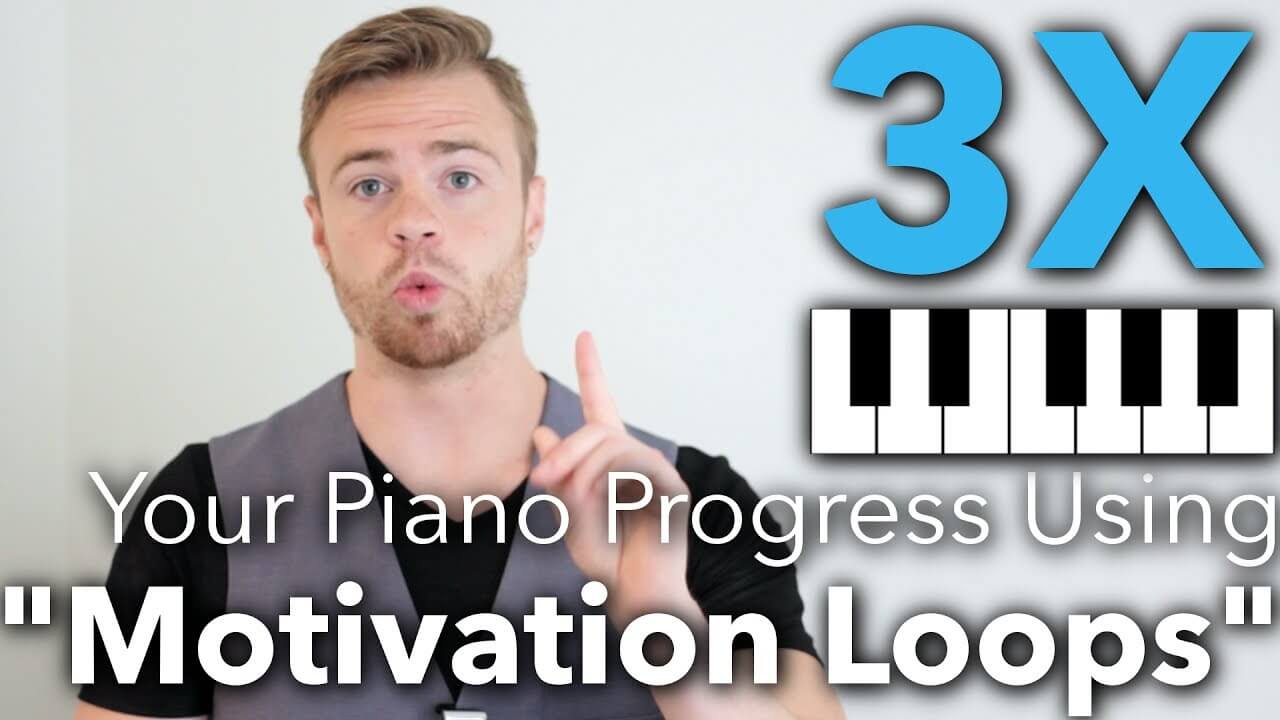Want to learn how to get better results from your piano practice? Today you’re going to learn how to use “Positive Motivation Loops” and the “Compound Effect” to multiply your piano progress. Also, you’re going to learn why “Results Per Minute of Practice Time” is the most important stat you want to focus on.
If you feel like you’re just stuck in your practicing, you’re practicing a lot and not making progress, I’m also going to teach you how to get unstuck so you can consistently make that big progress when you’re practicing.
The Most Important Skill for Learning Piano
I get asked all the time, “What’s the most important skill for learning piano?” While most people say it’s scales, play by ear, or some other aspect of it, I’d say the number one skill for learning to play piano is the skill of practicing.
The problem is most teachers and most students don’t see practicing as a skill. They think that you just go to the piano and practice. However, there’s actually an art to structuring your practice in a very efficient way.
The reason it’s important to have efficiently structured practice is that this puts a multiplier on every aspect of your piano skills. If you want to get good at sight reading for example and you practice efficiently, you can 2X, 3X, 4X the progress you make on your sight reading. Same goes for your technique practice as well. This is why getting your practice sessions efficient is like rising the tide for everything else you do after that.
The biggest reason you want to focus on the skill of practicing is because it’s absolutely critical for motivation. Let me explain.
There’s basically two types of motivation and the problem is most piano students only use the first type.
The first type is kind of obvious where you’re motivated by the music itself. You think, “Wow, that’d be SO cool if I could play that song!” The problem is this is a SHORT term motivation strategy. Within 3, 4, 5 days, if you’re still trying to learn the music and still haven’t got up to it full speed and haven’t heard yourself play the song that motivation starts to fade. That’s why a ton of people get jacked up about a certain song, but when they haven’t learned it in a few days they quit. This used to happen to me all the time!
The second type of motivation is a LONG TERM form of motivation – motivation by accomplishment. This is where you do something, get the results, and feel good about it. We train this type of motivation by setting goals and subgoals, and then having specific strategies for accomplishing them. I’m going to tell you about a system for how to do this in a little bit.
This is a KEY difference between the attitudes of students who make it in piano and students that quit – the ability to use this second type of motivation to stay on track. Utilizing this second form of motivation is also the ONLY way I’ve found to stay motivated with boring (but important!) technique exercises.
Results Per Minute of Practice Time
The most important statistic you should focus on as a piano player is the results per minute of practice time. I’m going to explain exactly why.
Let’s say you practice a song for four hours and you get four measures of the song learned. That’s not going to keep you motivated if you’ve only learned a measure each hour. Instead, what if you practice for one hour and got four measures learned? You would be learning a new measure every 15 minutes now. At this rate you can also see the progress much easier. If progress is too slow our brains can’t “see” the progress so it doesn’t lead to motivation. This is why it’s way more important to use results per minute instead of total results.
Now, let’s think about your long-term progress. Just for an example, let’s say with person A, every hour they practice they gain 1% in their abilities. Now, let’s say person B, with every hour they practice, gains 2% in their piano abilities. The difference between 1% and 2% is a very small amount in the short term, but over a year of practicing the difference between these turns out to be bigger and bigger.
Creating a Positive Motivation Loop
To explain what a positive motivation loop is, first I’m going to tell you about a negative motivation loop.
A negative motivation loop is where you practice, don’t get very much results, and the next day you’re less motivated to practice, still don’t really get any results, and it spirals down from there. You start skipping practice days, cut practice sessions short, get more distracted in your practice sessions, and you get even less results which, of course, makes you less motivated and leads to even less results.
On the other hand, let’s say you’re creating a positive motivation loop. You wake up, practice, and get a lot of results for a small amount of practice time. Now you wake up the next morning, you look at your goal sheet, and see all the boxes you’ve marked off. You see the progress you’ve made, and now when you practice the next day you’re excited to practice.
Then, you practice more, get more results, and can’t help but think how awesome it is that you’ve been making so much progress. Because of this, you’re now very consistently practicing and you’re very focused every time you’re practicing. This leads to you practicing even more and that’s when everything spirals up for you.
You know what the key factor is that determines whether you spiral up or down? Your results per minute.
The Compound Effect
If you’ve ever had a 401K or any kind of investment you understand that the idea of compound interest is essentially what makes people millionaires.
Let’s say we invest $1,000 per month over the course of 10 years. In that 10 years you don’t only gain that $1,000 per month that you’ve been putting in, you also gain the interest on top of that. And then that interest makes money on the interest. This is how you can basically exponentially ramp up your savings. Piano works the same way.
If you’re practicing piano 30 minutes per day, using accomplishment motivation and checking off your goals every day, and staying motivated, something cool happens. Because you’re so motivated, seeing how much progress you’re making, let’s say you now practice 45 minutes a few days per week. As time goes on you might then practice an hour some days. That extra motivation leads to even more practice time.
The extra 15 or 30 minutes per day you’re practicing on top of your normal practice time is like interest. This is time you wouldn’t normally have practiced without the extra motivation. Because you’re now in this positive motivation loop, with all of this interest and extra practice time, you also achieve a higher results per minute of practice time leading to even more motivation. This goes back to that idea of gaining 2% in a practice session vs. gaining 1% in a practice session.
The compound effect is really how people increase their piano skills faster over time and get results others can only dream about.
Staying in a Positive Motivation Loop
Do you want the exact protocols and systems I use to stay in a positive motivation loop?
In my free Become a Piano Superhuman Course I have a lesson on “Goal setting and song mapping” that goes in-depth on these topics I’ve mentioned. Check it out and take your piano skills to the next level.

